

Best practices for designing cards - UX Planet. Ux cards lallemand fr v1. Le Card Design : vers un nouveau paradigme UX. Fortement popularisé par les réseaux sociaux, le Card Design est l’une des grandes tendances actuelles en design d’interfaces.

Adoptée par de plus en plus de sites et applications mobiles, cette approche ergonomique est déjà considérée comme le futur du web. Inspiré par le Metro Design design de Windows et démocratisé par la plateforme Pinterest, le Card Design consiste en une présentation du contenu sous forme de petits blocs agencés sur une grille. Le modèle UI Metro créé par Windows pour son système d’exploitation Windows 8 Pinterest utilise le principe de l’infinite Scroll pour naviguer à travers ses 50 milliards d’épingles Généralement composée d’un titre, d’un rich média et d’un texte concis, l’objectif d’une Card est de proposer un condensé d’informations et d’y ajouter des possibilités d’interactions via des liens et/ou des boutons. UX Cards – une approche psychologique du design UX. Les UX Cards ont pour but de soutenir la conception et l’évaluation de l’expérience utilisateur dans les systèmes interactifs.
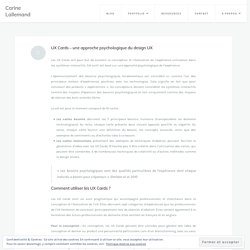
Cet outil est basé sur une approche psychologique de l’expérience. L’épanouissement des besoins psychologiques fondamentaux est considéré ici comme l’un des principaux moteur d’expériences positives avec les technologies. Cela signifie en fait que pour concevoir des produits « expérientiels », les concepteurs doivent considérer les systèmes interactifs comme des moyens d’épanouir des besoins psychologiques et non uniquement comme des moyens de réaliser des buts orientés tâche. Le set est pour le moment composé de 10 cartes : Les cartes besoins décrivent les 7 principaux besoins humains (transposables au domaine technologique)
. « Les besoins psychologiques sont des qualités particulières de l’expérience dont chaque individu a besoin pour s’épanouir » Sheldon et al. 2010 Comment utiliser les UX Cards ? Prochaines étapes Téléchargez gratuitement les UX Cards ! S'CAPE-Design Thinking. Le paysage des escape games pédagogiques s’enrichit aujourd’hui d’une nouvelle publication.
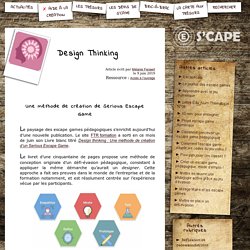
Le site FTR formation a sorti en ce mois de juin son Livre blanc titré Design thinking : Une méthode de création d’un Serious Escape Game. Le livret d’une cinquantaine de pages propose une méthode de conception originale d’un défi-évasion pédagogique, consistant à appliquer la même démarche qu’aurait un designer. Cette approche a fait ses preuves dans le monde de l’entreprise et de la formation notamment, et est résolument centrée sur l’expérience vécue par les participants. Les auteurs déclinent les cinq piliers du Design thinking : Empathie, Définition, Idéation, Prototype et Test. Ils esquissent ainsi au fil des pages une démarche intéressante, assez générale pour être exploitée en formation comme avec des élèves.
Le site offre deux accès à l’ouvrage : un document PDF gratuit, mais aussi une version brochetée vendue à prix coûtant. Moodle. Moodle. Moodle. INTEGRATION OF DESIGN THINKING AND INSTRUCTIONAL. Design Thinking for the Instructional Designer. Over the holidays, I received a gift I had asked for: a container garden for our back porch.
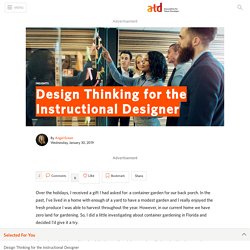
In the past, I’ve lived in a home with enough of a yard to have a modest garden and I really enjoyed the fresh produce I was able to harvest throughout the year. However, in our current home we have zero land for gardening. So, I did a little investigating about container gardening in Florida and decided I’d give it a try. My experience learning about container gardening has been very pleasant. In the preparation stage, I sought information about the types of container gardens that worked best on porches, the kinds of vegetables and plants that were ideal for growing in containers, and the best way to get started. Once I felt confident that I knew what I needed to get started, I headed to the store and purchased the seeds, soil, fertilizer, and tools.
So, how different is my experience learning to container garden from the learning experiences that employees go through inside an organization? How To Use Design Thinking In Learning Experience Design. Design Thinking For Instructional Design, Part 2: The Process. In the first article of this series, I introduced readers to the fundamental reasons why I believe, as an industry, we need to adopt a new approach to Instructional Design.
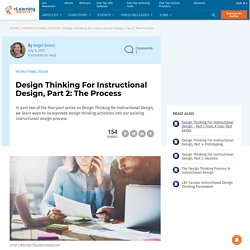
This new approach to designing and developing instructional products utilizes a method of human-centered design called design thinking. Incorporating design thinking into our existing process can help us create a better instructional product. Understanding the nuances of human behavior is difficult. Humans are messy and complex. Our needs are often hard to articulate, but easy to “feel” when left unmet. Design Thinking For Instructional Design - Part 1 From A Four-Part Series. According to Harvard Business Review, US organizations spend over $160 billion dollars on employee training and education, with global figures estimated as high as $356 billion.
That’s billion; with a B. That is a lot of money being spent on training. So, how great of a return are we, the Learning and Development (L&D) function, providing to our business partners for that investment? Well, nearly 75% of the senior managers and leaders in the organizations polled by CEB were dissatisfied with the performance of their L&D department.
Moodle. Design thinking et formation : quelle promesse ? La notion de parcours apprenant : les Humainsavant les contenus A l’instar des parcours d’achat dans la vente de produits ou services, le design thinking - ou human-centered design pour les puristes - permet d’acquérir une compréhension détaillée de l’environnement d’apprentissage dans lequel évolue un individu.
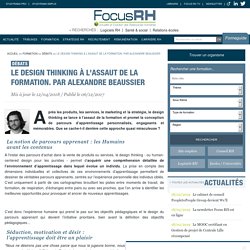
La prise en compte des dimensions individuelles et collectives de ces environnements d’apprentissage permettent de dessiner de véritables parcours apprenants, centrés sur l’expérience personnelle des individus ciblés. C’est uniquement à partir de ces cartographies brouillant les pistes entre moments de travail, de formation, de respiration, d’échanges entre pairs ou avec ses proches, que l’on arrive à identifier les meilleures opportunités pour provoquer et ancrer de nouveaux apprentissages.
Séduction, motivation et désir :l’apprentissage doit être un plaisir.